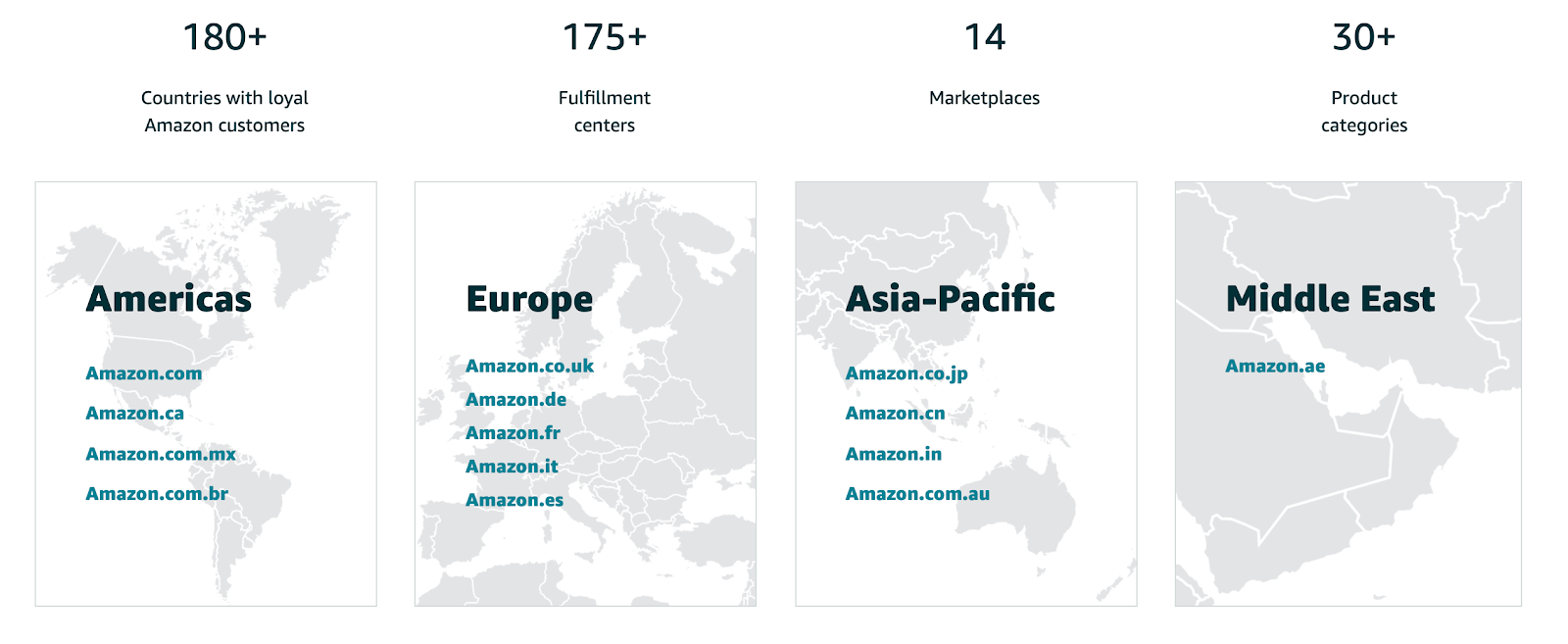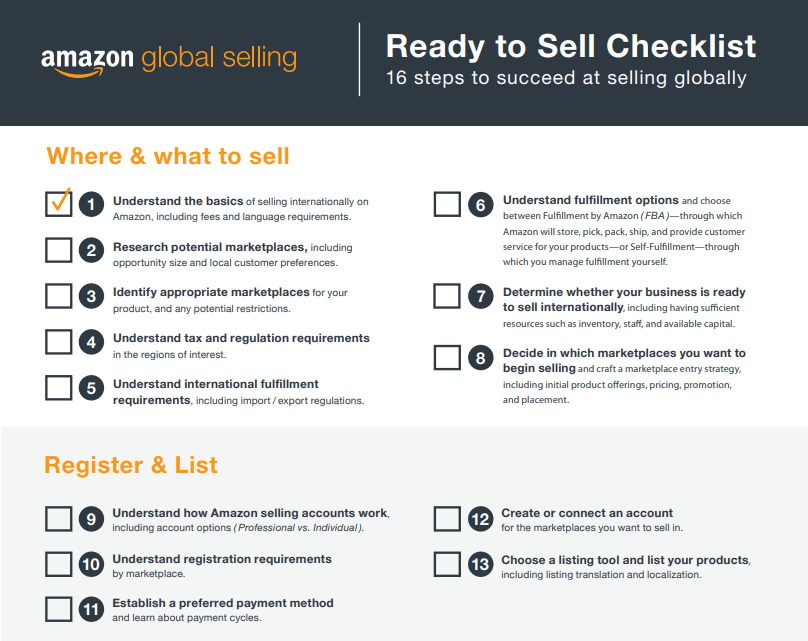Due to fierce competition, brands selling on the Amazon platform are always asking the question “What is the next expansion opportunity?”
A logical option is to utilize the Amazon Global and Fulfillment by Amazon (FBA) Export programs to reach new international customers. And these programs are picking up some serious steam.
Earlier this year, Business Today reported that Amazon Global had exceed $1 billion in cumulative e-commerce exports sales across 2016-19 from Indian sellers alone. However, international expansion is a big step, and it’s important that brands understand all the pros and cons.

As an agency, Bobsled has helped countless clients both formulate and execute successful expansion initiatives. Therefore, we thought it would be useful to break down the nuts and bolts of how the Amazon Global and FBA Export programs function and what questions brands need to ask before taking the plunge.
If you’d like to reach more Amazon customers globally but feel unsure about the specific implications, then this article is for you!
What Are the Amazon Global and FBA Export Programs?
First of all, let’s distinguish the differences between the two different programs.
The Amazon Global program allows brands to create product listings in new international marketplaces.
For example, a U.S.-based Amazon.com seller could use the program to list their product offering on the Amazon.co.uk marketplace. This means that Amazon UK shoppers are able to find and purchase these products on the Amazon.co.uk marketplace.
The FBA Export program is a little different because brands don’t create product listings in new international marketplaces, but the program still allows them to connect with international shoppers.
Let’s use the same example from above, a U.S.-based Amazon.com seller. If this seller decides to enroll all of their eligible Amazon.com products in the FBA Export program, international shoppers can find and purchase these products on Amazon.com, and Amazon will ship the product directly to the international customer.
Why Should Brands Consider Implementing the Programs?
Differentiation is a core part of any successful e-commerce strategy. If brands can tap into new markets ahead of snoozing competitors, this translates to more revenue and awareness in the short term that can be scaled significantly over time.
Expanding into untapped markets to reach more customers is hardly a new strategy. However, by partnering with Amazon, brands can avoid a lot of standard headaches that typically come with exploring new market opportunities:
- Trust. Amazon is a global brand with extreme customer loyalty, and many Prime shoppers complete the vast majority of their e-commerce transactions on Amazon. By partnering with Amazon, brands are putting their products exactly where a lot of people want to shop.
- Infrastructure. Setting up a warehouse and fulfillment team in a new country is a costly and complicated exercise. By partnering with Amazon, brands can avoid such hardships, especially if they choose to utilize FBA.
At this point, you might be wondering whether you are eligible to participate in the programs. Let’s take a closer look.
Who Can Enroll in Amazon Global and FBA Export?
Anyone with a Seller account can enroll in the Amazon Global program. But a brand must create a new account for each marketplace they enter.
For example, if a U.S.-based seller wishes to start selling on Amazon Australia, they must create a new Amazon.com.au Seller account. The exceptions here are the North American (U.S., Canada, and Mexico) and European (UK, Germany, France, Italy, and Spain) unified accounts. If a U.S.-based seller wishes to expand to another market within their existing unified account, e.g., Canada, they do not need to create a separate account.
It’s important to note that there is a similar program for European sellers called the European Fulfillment Network (EFN). This program allows European sellers to expand to any or all of the five EU markets yet continue to store all their FBA inventory in one country.
So, for example, a UK-based business could use EFN to create listings on Amazon.de without needing to ship any product to Germany, and when someone orders a product on Amazon.de, the UK fulfillment team will ship the product to the customer in Germany.
The FBA Export program is only available to brands with Amazon.com or Amazon.co.uk Seller accounts that utilize FBA. Sellers who utilize Fulfillment by Merchant (FBM) cannot participate in the program.
Which New Markets Can I Reach, and How Long Will It Take?
There are fourteen different Amazon marketplaces you can reach via Amazon Global.

Image Source: amazon.com
As the above infographic shows, Amazon has customers in 180+ countries. So by participating in FBA Export, you are opening up eligible products to all of these markets.
If you are already utilizing FBA for export-eligible products, you can make these products available to international customers via FBA Export immediately. In fact, most sellers are automatically enrolled in the program, so this may already be set up. Either way, you can enable or disable FBA Export in “Export Settings” within Seller Central for all eligible products at any time.
In terms of the timeline for getting started on Amazon Global, the process is completely dependent on how you choose to engage with the program. Specifically, how long it takes you to build product listings in the new marketplace/s and your inventory preparation/shipment process.
What Is the Process for Enrolling in the Programs?
The process for enrolling in the FBA Export program is very simple.
The first step is to identify which of your products are export-eligible. Amazon has outlined all the export and import restrictions here. Then, you should create an FBA shipment for all eligible products you would like to make available for international customers. Finally, decide which countries you’d like to open your products to, ensuring that FBA Export is enabled in “Export Settings” within Seller Central.
Amazon will fulfill your international orders, handle import duty/customs clearance, and ship your product to the international buyer’s address. International buyers pay international shipping costs and customs duty. As a seller, you will simply pay Amazon the regular FBA fees—there is no extra cost to participate in the FBA Export program. If you need help calculating your FBA fees, please see our article “Know Before You Sell: Introducing Our Automated FBA Product Fee Calculator,” and download our automated fee calculator.

Getting set up with Amazon Global is a little more complicated.
First, you’ll need to decide which new markets to target and what products you’d like to prioritize. You’ll then need to register and list your products in each new marketplace. It’s important to note that Amazon requires you to translate all products listings to the local market language, e.g., products listed on Amazon.it need to be translated to Italian.
The next step is to decide on your fulfillment method. You could either choose FBA or choose to fulfill orders yourself (FBM). Your decision here will impact your Amazon fees across each marketplace.
Choosing FBA means that Amazon will take care of all fulfillment/customer service/returns, and customers in your new market will likely receive orders a lot quicker than with FBM. On the other hand, you will have to create a large international shipment, which could be costly, and your inventory will be stored in a new country that could have taxation implications.
Conversely, choosing FBM means that you don’t have to take a risk by creating a large international shipment—you simply ship individual orders as they come in. You continue to store all inventory in your home country, potentially avoiding taxation implications. However, you will be responsible for all customer service tasks (in the local market language), and you will likely have a long shipping timeline, which will probably hurt sales.
On top of everything, there is the ongoing management of the new marketplace/s (order fulfillment, customer service, marketing tasks, inventory management, catalog expansion).
Amazon has put together a useful Amazon Global checklist, which fleshes out each step in more detail.

Image Source: amazon.com
Why Would a Brand Avoid International Expansion?
Despite the vast opportunity that exists, there are several reasons why a brand would consider avoiding both international expansion programs.
Product eligibility in new markets is perhaps the most important thing brands should assess before any expansion plans are formulated. Each country has unique specifications in respect to the legality of certain products, and although Amazon does have a vetting process, it’s important to do your own due diligence to avoid compliance headaches down the line.
Another potential issue you will have to consider is customer disappointment due to cost and shipping problems. Put simply, it’s crucial to place the customer experience front of mind when considering any new initiative on Amazon.
With the FBA Export program, the international shipping fees are passed on to the customer, and if there’s an issue with the product, the customer will need to create an international shipment to return the product and receive a refund.

Likewise, with the Amazon Global program, many brands may need to adjust the selling price of items in new markets to account for additional shipping and importing costs. This may result in customer dissatisfaction, especially if there’s a large discrepancy in cost compared to costs in the home marketplace.
Inevitably, additional admin and customer service load will also be one concern. By expanding into a new market, you’re looking at an increased admin and customer service load, especially if you opt for FBM over FBA. This will be exacerbated if language translation is required.
Tax implications. Amazon encourages sellers to utilize its impressive global infrastructure, but it’s important that every brand considering international expansion knows the tax implications of selling in each new market.
In this respect, the details really matter, and having a clear understanding of the taxation laws within each region will allow you to make important strategic decisions, e.g., in-house management using FBA versus selling wholesale to an established distributor using FBM.
Existing distributor agreements. Brands should consider any preexisting authorized distributor agreements before entering a new market. Creating your own in-house Amazon account could create issues with important stakeholders.
General Recommendations
Each brand considering international expansion obviously has its own unique parameters to consider. But there are certain general recommendations that the vast majority of sellers should pay attention to.
Your Existing Sales Data and Market Intelligence Is Incredibly Useful
Some brands are lucky to have useful data at their fingertips that will inform them how they should start their expansion journey:
- FBA Export Orders. Review all FBA Export orders, and see if there’s a geographical trend in terms of past customer location.
- E-Commerce Website Data. Likewise, if you accept international orders through your e-commerce website, review this geographical data for trends.
- Distributor Intel. Your Distributor POs may indicate which new markets are the most attractive and which products have the most potential.
New Market Research
Not all Amazon markets are created equal. For example, Amazon UK and Germany are far larger than the other European marketplaces when one analyzes total market size. In addition, brands should be considering their niche, as even smaller markets have extremely crowded product categories.
When entering a crowded marketplace, a brand will need to go the extra mile to stand out from the competition and reach new customers. On the other hand, less competitive markets will generate less revenue now, but it’s generally an easier path to a strong Best Seller Rank, and the total market size may grow considerably over time.
In summary; to avoid disappointment, it’s important to have a clear understanding about the true nature of each Amazon marketplace to accurately quantify it’s potential.
Consider All The Factors To Seize the Opportunity
Yes, there’s a lot to take in when it comes to this international selling on Amazon. But remember, there might be many things to consider, but there are also many opportunities awaiting.
Hopefully, this overview has been helpful. If you’d like to discuss how Bobsled could assist with your global expansion, please schedule an appointment below.
